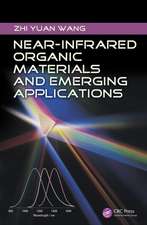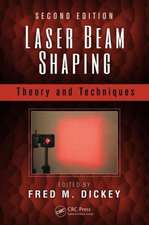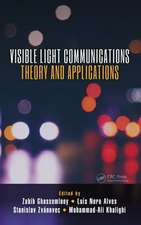Nanophotonics: Springer Series in Optical Sciences, cartea 213
Autor Arthur McGurnen Limba Engleză Hardback – 14 mai 2018
Topics include: The basic mathematical techniques needed for the study of the materials of nanophotonic technology; photonic crystals and their applications as laser resonators, waveguides, and circuits of waveguides; the application of photonic crystals technology in the design of optical diodes and transistors; the basic properties needed for the design and understanding of new types of engineered materials known as metamaterials; and a consideration of how and why these engineered materials have been formulated in the lab, as well as their applications as negative refractive index materials, as perfect lens, as cloaking devices, and their effects on Cherenkov and other types of radiation. Additionally, the book introduces the new field of plasmonics and reviews its important features. The role of plasmon-polaritons in the scattering and transmission of light by rough surfaces and the enhanced transmission of light by plasmon-polariton supporting surfaces is addressed. The important problems of subwavelength resolution are treated with discussions of applications in a number of scientific fields. The basic principles of near-field optical microscopy are presented with a number of important applications. The basics of atomic cavity physics, photonic entanglement and its relation to some of the basic properties of quantum computing, and the physics associated with the study of optical lattices are presented.
| Toate formatele și edițiile | Preț | Express |
|---|---|---|
| Paperback (1) | 1369.56 lei 6-8 săpt. | |
| Springer International Publishing – 10 ian 2019 | 1369.56 lei 6-8 săpt. | |
| Hardback (1) | 1375.77 lei 6-8 săpt. | |
| Springer International Publishing – 14 mai 2018 | 1375.77 lei 6-8 săpt. |
Din seria Springer Series in Optical Sciences
- 24%
 Preț: 945.45 lei
Preț: 945.45 lei - 18%
 Preț: 1818.90 lei
Preț: 1818.90 lei - 18%
 Preț: 2088.12 lei
Preț: 2088.12 lei - 20%
 Preț: 568.46 lei
Preț: 568.46 lei - 18%
 Preț: 1100.04 lei
Preț: 1100.04 lei - 18%
 Preț: 982.87 lei
Preț: 982.87 lei - 18%
 Preț: 941.47 lei
Preț: 941.47 lei - 18%
 Preț: 877.05 lei
Preț: 877.05 lei -
 Preț: 276.15 lei
Preț: 276.15 lei - 15%
 Preț: 637.63 lei
Preț: 637.63 lei - 18%
 Preț: 1806.98 lei
Preț: 1806.98 lei -
 Preț: 373.51 lei
Preț: 373.51 lei - 18%
 Preț: 1382.66 lei
Preț: 1382.66 lei - 18%
 Preț: 1223.79 lei
Preț: 1223.79 lei - 18%
 Preț: 1542.43 lei
Preț: 1542.43 lei - 18%
 Preț: 2060.05 lei
Preț: 2060.05 lei - 18%
 Preț: 1207.10 lei
Preț: 1207.10 lei - 15%
 Preț: 632.81 lei
Preț: 632.81 lei - 18%
 Preț: 938.35 lei
Preț: 938.35 lei - 18%
 Preț: 931.38 lei
Preț: 931.38 lei - 18%
 Preț: 1220.58 lei
Preț: 1220.58 lei - 18%
 Preț: 931.06 lei
Preț: 931.06 lei -
 Preț: 385.64 lei
Preț: 385.64 lei - 18%
 Preț: 980.70 lei
Preț: 980.70 lei - 18%
 Preț: 1535.90 lei
Preț: 1535.90 lei - 18%
 Preț: 1091.50 lei
Preț: 1091.50 lei - 15%
 Preț: 640.23 lei
Preț: 640.23 lei -
 Preț: 407.75 lei
Preț: 407.75 lei - 18%
 Preț: 936.51 lei
Preț: 936.51 lei - 15%
 Preț: 630.23 lei
Preț: 630.23 lei
Preț: 1375.77 lei
Preț vechi: 1677.77 lei
-18% Nou
Puncte Express: 2064
Preț estimativ în valută:
263.37€ • 270.87$ • 218.50£
263.37€ • 270.87$ • 218.50£
Carte tipărită la comandă
Livrare economică 19 februarie-05 martie
Preluare comenzi: 021 569.72.76
Specificații
ISBN-13: 9783319770710
ISBN-10: 3319770713
Pagini: 500
Ilustrații: XII, 558 p. 98 illus., 10 illus. in color.
Dimensiuni: 155 x 235 mm
Greutate: 0.97 kg
Ediția:1st ed. 2018
Editura: Springer International Publishing
Colecția Springer
Seria Springer Series in Optical Sciences
Locul publicării:Cham, Switzerland
ISBN-10: 3319770713
Pagini: 500
Ilustrații: XII, 558 p. 98 illus., 10 illus. in color.
Dimensiuni: 155 x 235 mm
Greutate: 0.97 kg
Ediția:1st ed. 2018
Editura: Springer International Publishing
Colecția Springer
Seria Springer Series in Optical Sciences
Locul publicării:Cham, Switzerland
Cuprins
General Introduction and overview of the text: Qualitative remarks about the systems and effects found in nanophotonics and their important technological applications.- Mathematical preliminaries.- Photonic crystals.- Metamaterials.- Plasmmonics.- Subwavelength focusing.- Near-field scanning optical microscopy.- Optical tweezers.- Trapped atoms.- Discussions of some of the basic techniques of experimental implementation of the ideas of nanophotonics.
Notă biografică
Prof. Arthur R. McGurn, CPhys, FInstP, is a Fellow of the Institute of Physics, a Fellow of the American Physical Society, a Fellow of the Optical Society of America, a Fellow of the Electromagnetics Academy, and an Outstanding Referee for the journals of the American Physical Society. He received the Ph.D. in Physics in 1975 from the University of California, Santa Barbara, followed by postdoctoral studies at Temple University, Michigan State University, and George Washington University (NASA Langley Research Center). The research interests of Prof. McGurn have included works in the theory of: magnetism in disorder materials, electron conductivity, the properties of phonons, ferroelectrics and their nonlinear dynamics, Anderson localization, amorphous materials, the scattering of light from disordered media and rough surfaces, the properties of speckle correlations of light, quantum optics, nonlinear optics, the dynamical properties of nonlinear systems, photonic crystals, and meta-materials. He has approximately 150 publications spread amongst these various topics. Since 1981 he has taught physics at Western Michigan University where he is currently a Professor of Physics and a WMU Distinguished Faculty Scholar. A number of Ph.D. students have graduated from Western Michigan University under his supervision.
Textul de pe ultima copertă
This book gives a readable introduction to the important, rapidly developing, field of nanophotonics. It provides a quick understanding of the basic elements of the field, allowing students and newcomers to progress rapidly to the frontiers of their interests.
Topics include: The basic mathematical techniques needed for the study of the materials of nanophotonic technology; photonic crystals and their applications as laser resonators, waveguides, and circuits of waveguides; the application of photonic crystals technology in the design of optical diodes and transistors; the basic properties needed for the design and understanding of new types of engineered materials known as metamaterials; and a consideration of how and why these engineered materials have been formulated in the lab, as well as their applications as negative refractive index materials, as perfect lens, as cloaking devices, and their effects on Cherenkov and other types of radiation. Additionally, the book introduces the new field of plasmonics and reviews its important features. The role of plasmon-polaritons in the scattering and transmission of light by rough surfaces and the enhanced transmission of light by plasmon-polariton supporting surfaces is addressed. The important problems of subwavelength resolution are treated with discussions of applications in a number of scientific fields. The basic principles of near-field optical microscopy are presented with a number of important applications. The basics of atomic cavity physics, photonic entanglement and its relation to some of the basic properties of quantum computing, and the physics associated with the study of optical lattices are presented.
Topics include: The basic mathematical techniques needed for the study of the materials of nanophotonic technology; photonic crystals and their applications as laser resonators, waveguides, and circuits of waveguides; the application of photonic crystals technology in the design of optical diodes and transistors; the basic properties needed for the design and understanding of new types of engineered materials known as metamaterials; and a consideration of how and why these engineered materials have been formulated in the lab, as well as their applications as negative refractive index materials, as perfect lens, as cloaking devices, and their effects on Cherenkov and other types of radiation. Additionally, the book introduces the new field of plasmonics and reviews its important features. The role of plasmon-polaritons in the scattering and transmission of light by rough surfaces and the enhanced transmission of light by plasmon-polariton supporting surfaces is addressed. The important problems of subwavelength resolution are treated with discussions of applications in a number of scientific fields. The basic principles of near-field optical microscopy are presented with a number of important applications. The basics of atomic cavity physics, photonic entanglement and its relation to some of the basic properties of quantum computing, and the physics associated with the study of optical lattices are presented.
Caracteristici
Provides a readable introduction to the important new field of nanophotonics, focusing on new device technologies and ideas Focuses on fundaments, making them clear to students wishing to rapidly develop an expertise in the field Serves as a good source of reference materials for nanophotonics















